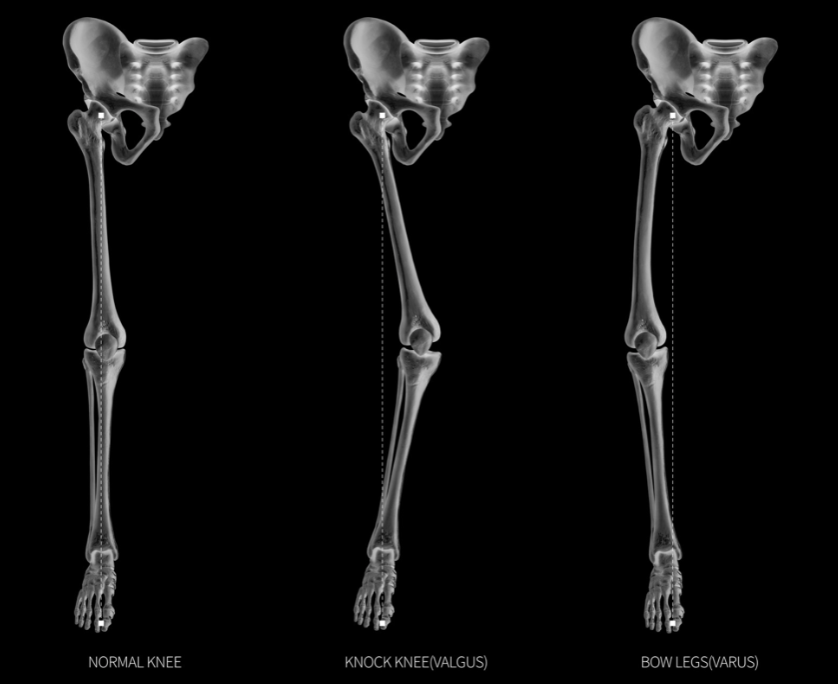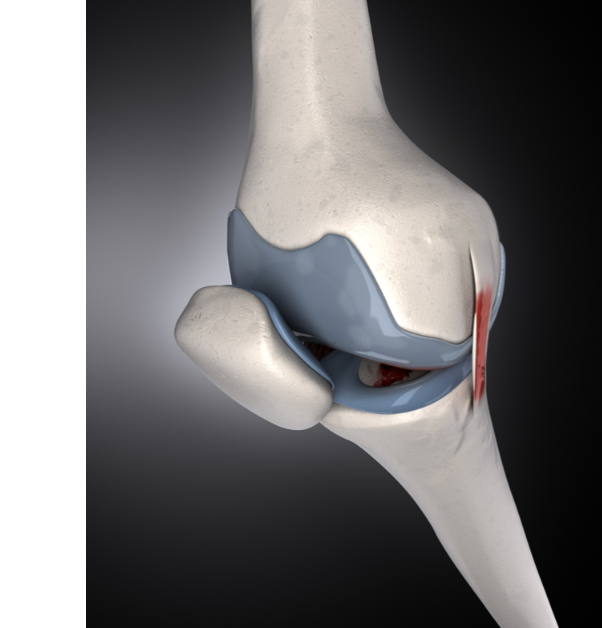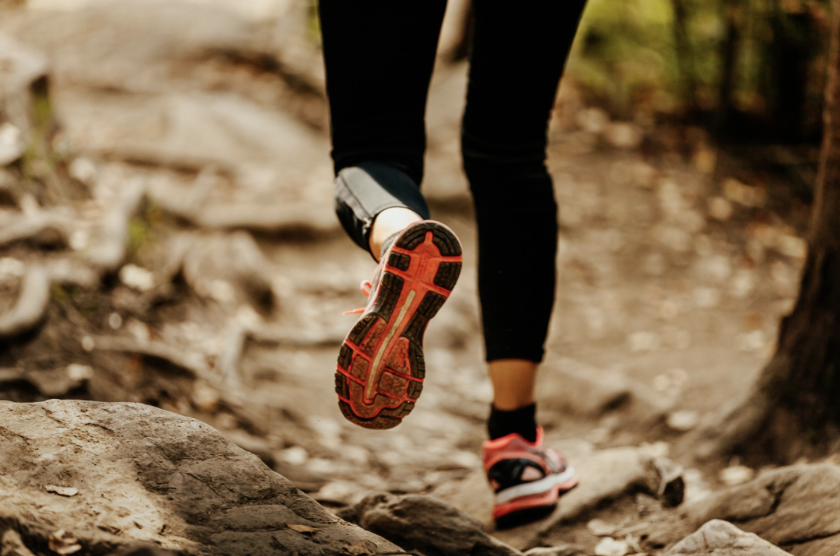Woman running. Does running cause knee osteoarthritis?
Image by sportpoint from canva.com
Some healthcare professionals may have you believe that running and other high impact activities will inevitably lead to “wear and tear” or damage to your knees. And that after enough use, your knees will develop osteoarthritis. You may have stopped running because you developed knee osteoarthritis or want to prevent knee osteoarthritis. But the research really does not support this “wear and tear” theory as loading your joints is actually essential for preventing osteoarthritis.[8]
Does running really cause knee osteoarthritis? What does the research say?
The short answer is that running itself does not cause knee osteoarthritis.[1][3][6] Running has a number of health benefits such as reduced cardiovascular disease, reduced obesity, improved mood, and prevention of other chronic diseases.[5][8] Research has consistently shown that a moderate amount of recreational long distance running does not cause knee osteoarthritis.[1][3][4][5][6][8] In fact, running may actually protect against knee osteoarthritis, as studies have shown that runners are less likely to develop knee osteoarthritis than non-runners.[1][3] Running can also prevent the development of obesity which has been shown to increase the risk of osteoarthritis.[1][8] There is also evidence that running reduces the risk of needing a knee replacement surgery due to osteoarthritis.[11]
One reason running has been linked to osteoarthritis and joint damage is that the impact forces on the knee are about four times higher with running versus walking.[8] But the problem with this theory is that when you consider the length of time the knee is being loaded and the distance covered, there is actually minimal difference in overall load on the knee for a given distance between running and walking.[8] And joint loading itself is actually very important for maintaining cartilage health in the knee.[8] Running increases blood flow and movement of joint fluid which helps maintain normal range of motion (ROM) and helps to deliver nutrients to cartilage.[8] In response to compression, the cells in the cartilage multiply and create more important components of cartilage such as proteoglycans and type II collagen.[2]

Image by Kintarapong from canva.com
Optimal joint loading depends not only on the load, but also on the ability of the joint to absorb that load. This is likely why there has been conflicting research in the past with respect to running and knee osteoarthritis.[8][11] Running, especially at high volumes, can lead to an increased rate of injury, and it has been shown that knee injuries increase the risk of knee osteoarthritis.[8] This may be one reason why some studies have shown that elite, high-volume runners may actually have increased risk of knee osteoarthritis.[8]
But generally, running can help to protect against knee osteoarthritis by allowing for proper joint loading to stimulate cartilage.[8] Where it could potentially be harmful is if you have weakness in the muscles surrounding the knee or malalignment of the knee (such as bow leg known as varus alignment).[8] Muscles are also very important in absorbing force. This is why it is important to gradually increase distance and volume of running, strengthen muscles in the hip, thigh and lower leg, and take appropriate time to recover from injury.[8] What is clear is that it is not just “wear and tear” that causes knee osteoarthritis, which is why running itself does not increase risk. What does increase risk is obesity, previous injury, and poor movement patterns that lead to loading the joint more than it can handle.When these factors are combined with running, the risk of knee osteoarthritis can increase.[8]
What if I’ve torn my ACL, is it still okay for me to run?
Now let’s discuss running after an ACL injury or surgery. It has been shown that both people with surgically reconstructed ACLs and non-operatively treated ACLs have an increased risk of developing knee osteoarthritis.[2] So, if you have had an ACL injury you are at a higher risk of osteoarthritis to begin with. But this does not mean that you should not run or that running will further increase your risk of knee osteoarthritis.
One theory for increased risk of knee osteoarthritis after ACL injury has to do with the movements and positioning of the knee and how this impacts loading of cartilage. As mentioned above, if cartilage is not loaded enough, it will thin and degrade, but loading beyond what the joint can handle is not good either.[2] With an ACL injury, the movements of the knee change both with and without surgical reconstruction.[2] Some of these changes include differences in translation and rotation of the tibia and bow leg (varus) positioning of the knee.[2][7][10] What this does is suddenly change where the cartilage is loaded.[2] This mature cartilage is now being loaded differently and it has a hard time adapting to load and cannot respond appropriately, which over time can lead to osteoarthritis. The same is true for the areas that are loaded less as a result of the changes in movements of the knee, and these are now underloaded which can also lead to osteoarthritis.[2]
Additionally, the injury is a factor that increases risk of osteoarthritis. Sometimes with an ACL injury there is injury to surrounding structures such as the bone, cartilage, menisci, and ligaments.[9] Osteochondral defects are areas of damage to cartilage and bone underneath. These are found commonly after ACL injury, especially when the ACL is not reconstructed.[9] The presence of the associated injuries, especially these osteochondral defects indicates significant damage has been done to the joint which may be what ultimately causes the post-traumatic osteoarthritis.[9]

Image by janulla from canva.com
There are a number of factors resulting from ACL injury that increase risk of osteoarthritis and these primarily have to do with joint loading. When it comes to running, the joint may be more vulnerable which does not mean you should not run but it means that you need to take precautions. Strengthening the surrounding muscles, avoiding excessive high-volume running,[9] and gradually increasing distance and volume can help to prevent overloading your knee and cartilage.[8] Focusing on maintaining good alignment is also important.[8] These things are also helpful for preventing a re-injury to your ACL. But overall, running can still be a good way to load your joints after ACL surgery as a moderate level does help maintain cartilage health.[8] It is also important to wait until your body is ready to return to running and get clearance from a health professional first.
Conclusion
In conclusion, moderate levels of running does not cause knee osteoarthritis and it can actually protect against osteoarthritis and subsequent joint replacement.[8][11] Running, with poor alignment, at excessively high volumes, with weak muscles, or without gradually increasing intensity can increase risk of osteoarthritis.[8] Wear and tear is not the reason you develop osteoarthritis but improper loading is what leads to cartilage degeneration. Loading your joints is essential for maintaining the health of your cartilage.[8]
If you have had an ACL injury there are a number of reasons why you may be at an increased risk of osteoarthritis.[2][9] But this does not mean you should avoid running. With proper strengthening and load management it will not increase your risk of knee osteoarthritis.[8][9] The Curovate physical therapy app for patients has ACL recovery protocols that can help you build strength, optimally load your knee, and determine when you are ready to return to the activities you enjoy, including running.
 |
 |
|---|
Other Related Blogs
- Am I at risk of tearing my ACL? How can I prevent an ACL injury? How can I avoid a reinjury to my ACL?
- What is an ACL and How is It Injured?
- Why Should I Exercise before My ACL Surgery- the Importance of ACL Prehabilitation
- I injured my ACL, what should I do?
- How to prevent ACL injuries
- When can I return to sport after an ACL injury or surgery?
- Did I retear my ACL graft?
- Is my ACL graft weaker than my original ACL? Or is my ACL graft stronger than my original ACL?
- What does the research say about non-operative ACL rehabilitation?
- When can I start jogging after ACL surgery?







